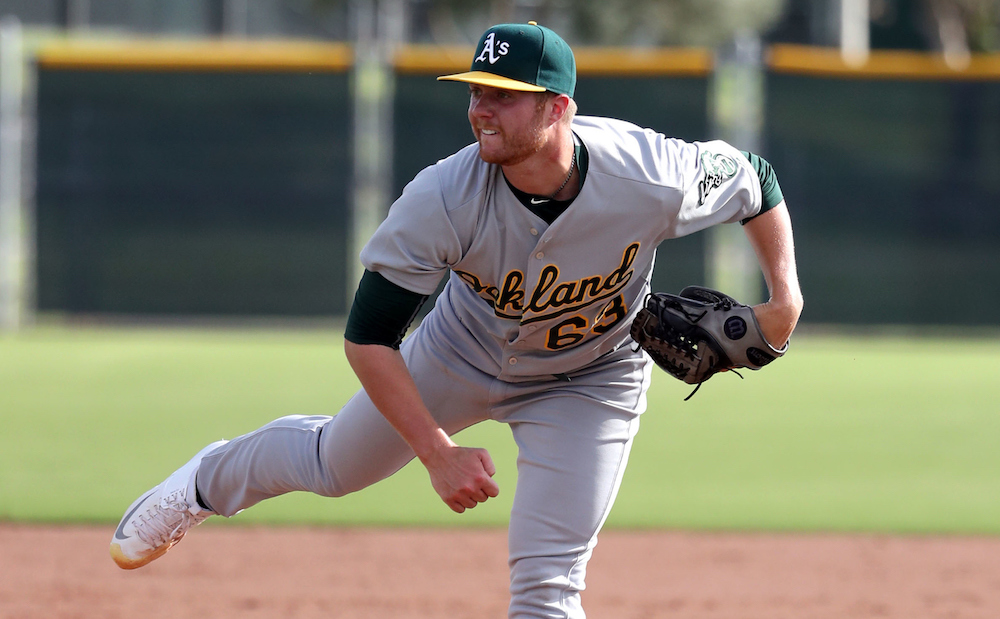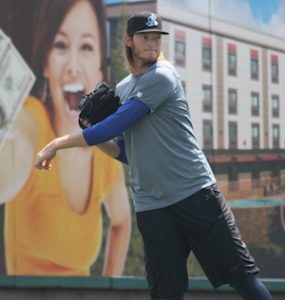Feature Photo: Logan Shore, RHP, Athletics
 In 2014, the Oakland A’s had a pitching problem. Normally a strength of their minor league system, the A’s starting pitching depth had thinned considerably. When A’s starters Jarrod Parker (RHP) and A.J. Griffin (RHP) went down with elbow injuries that spring, Oakland was faced with a thin rotation at the big league level and no depth at Triple-A Sacramento (where they played before moving the club to Nashville in 2015) to fill in the gaps. That void had significant repercussions, as the A’s were forced to trade significant assets to acquire right-handers Jeff Samardzija and Jason Hammel and lefty Jon Lester at the July 2014 trade deadline.
In 2014, the Oakland A’s had a pitching problem. Normally a strength of their minor league system, the A’s starting pitching depth had thinned considerably. When A’s starters Jarrod Parker (RHP) and A.J. Griffin (RHP) went down with elbow injuries that spring, Oakland was faced with a thin rotation at the big league level and no depth at Triple-A Sacramento (where they played before moving the club to Nashville in 2015) to fill in the gaps. That void had significant repercussions, as the A’s were forced to trade significant assets to acquire right-handers Jeff Samardzija and Jason Hammel and lefty Jon Lester at the July 2014 trade deadline.
Over the past three years, the A’s have worked to rebuild their organizational pitching depth. In 2016, the A’s used their first three draft picks on polished college starting pitchers – A.J. Puk, (LHP, Florida at #6), Daulton Jefferies (RHP, Cal at #37) and Logan Shore (RHP, Florida at #47), and Oakland has acquired several high-profile pitching prospects in deadline deals the past two Julys. The results have been noticeable. The A’s have three rookies on their current pitching staff (right-handers Frankie Montas, Raul Alcantara and Jharel Cotton) and 2080 Baseball recently ranked nine pitchers among the A’s top-15 prospects in their 2017 organizational review of the A’s farm system.
An abundance of quality starting pitching created an interesting problem for the A’s front office this offseason when they were plotting out their player development plans for 2017: how should they divide up the starting pitcher innings throughout the system? To tackle the issue, the A’s front office brought in minor league pitching coordinator Gil Patterson, big league pitching coach Curt Young and big league bullpen coach Scott Emerson for a brainstorming session. At the end of the meetings, the group had devised an eight-man, tandem-starter-rotation system that they felt would allow for the maximum amount of starting pitcher development, while also protecting the health of their young pitchers.
Tandem rotations aren’t a new concept in baseball, but the A’s have always been one of the biggest proponents of its usage. Oakland was one of the first organizations to put a tandem-rotation system into use back in the mid 1990s. The A’s even rolled out tandem starters at the big league level for one week in 1993. Since then, the A’s have mixed in tandem systems into their starting rotations at the lower levels frequently, and they’ve used tandems to fill one-or-two rotation spots at the upper levels from time-to-time.
Other organizations have used tandem rotations, including the Cardinals and the Astros. In 2013, as part of their system rebuilding process, the Astros rolled out eight-man-tandem rotations at every minor league level. The A’s are employing something similar in 2017, with eight-man-tandem rotations for every affiliate in the system — save for Triple-A Nashville.
According to A’s director of player development Keith Lieppman, each tandem starter will have a 65-to-75 pitch limit per outing. The pairs will trade off every outing as to which pitcher begins the game and which pitcher comes on in relief. In many cases, the second pitcher will start his outing with a clean inning, but as the season progresses, the second pitcher will sometimes be called on with runners on base. Starters will pitch on three-days’ rest instead of the traditional four days.
The overall goal of the program is to get as many innings from the roster’s eight best arms while also giving those pitchers a chance to experience both starting and reliever roles. In the process, the A’s believe their starters will learn to be more efficient with their pitches, and build confidence as they have success while only having to turn a line-up over once in most cases.
“There has been some talk around the whole game of baseball that only turning a lineup once or twice can be a benefit to the team. Ultimately, that’s everybody’s goal: to win championships,” Patterson said. “In general, you normally say your five better pitchers are the starters and then you have your important bullpen members and your closer. All of those guys are important because if they don’t pitch well, you don’t get the ball to the closer. In this realm, it was a little bit of the same thing, in that we increase the chances of getting that ball to the closer when we have a starter only face a lineup once or maybe a few extra guys. We also considered a little bit of health, that maybe with lesser workload – 65 pitches instead of 100 – we can keep guys healthier. You do come back on three-days’ rest instead of four, but it’s only 65 pitches rather than the 100. You still have your workday in the middle that allows for some development.”
The High A Stockton Ports are one of the three A’s full-season affiliates employing the tandem-starting-rotation system. Three of the eight starters in the rotation are the A’s top picks from 2016 – Puk, Jefferies, and Shore – and the rotation also features several other highly regarded pitchers in the A’s system. The first two times through the eight-man rotation saw the Ports’ pitching staff allow just 22 earned runs in 75 innings (2.52 ERA). Stockton pitchers struck out more than a batter an inning, walked just 21 and posted an impressive 1.13 WHIP.
Patterson sees the eight-man-rotation system as a way for the A’s to create a winning atmosphere while also enhancing their pitchers’ development.
“If the pitchers do what they are supposed to do, you are going to have eight guys at every level (except Nashville) with 130-to-140 innings. That’s a solid minor league season,” Patterson said. “That’s a great foundation to go to the big leagues. For me, it’s a wonderful opportunity to see how it helps with health, how it helps with performance and I don’t think these guys would mind four innings, allowing no or one run every time they take the mound for the next 30-to-35 outings. It’s going to be a lot of fun for me to see how this all plays out.”
Ports’ pitching coach Steve Connelly believes the tandem-rotation system will particularly benefit younger pitchers who are still getting their feet wet as professionals.
“If you are looking at it from a numbers standpoint and what OPS does the second and third time through the lineup, it really helps them to find some success early in their careers,” Connelly said. “With a team that is so young with prospects like we are, it can help first-year players to find that success and jump start the momentum and career path for them. It can be a great thing.”
Connelly also sees the tandem system benefitting pitchers when they reach the big leagues.
“These guys, more times than not, when they get called up to the big leagues, they are going to get called up as a reliever,” Connelly said. “What we haven’t always done a great job with is allowing our starters an opportunity to learn how to warm up in the middle of a game before they get to the big leagues. From the perspective of this is going to help these guys to be more prepared when they get the opportunity [in the big leagues], it’s a wonderful thing.”
With the starters coming back on one-days’ less rest, the in-between-start workout routine changes for those pitchers. Connelly says that how each pitcher approaches his days in-between outings will depend on how that pitcher fared in his previous appearance.
“From a side-work standpoint, we are limiting the number of throws. We are going to do some halves and take time off in-between starts. Instead of throwing a 30-or 35 pitch side, we might lengthen the distance a little bit and shorten the number of throws some,” Connelly said. “In other weeks, we might have more throws. It’s a week-to-week thing to find out how the body is talking to the players and what the body is telling the players to do. If a pitcher gets less work in a game, he might be able to get more work on the side in that case.”
Both Patterson and Connelly acknowledge that there will be challenges in maintaining this system throughout a full season that will include the inevitable injuries and player promotions. Patterson says the A’s are employing the eight-man-tandem rotations even at Extended Spring Training, and that the staff has pitchers in mind for every level should player movement create an opening in any of the tandem spots.
“You also have to make sure and be cognizant of the bullpen,” Patterson said. “If all of the games go with both tandem starters throwing four innings, it can create a problem in the bullpen because everyone has to get better and you can only get better by pitching. We will be balancing that all season.”
Connelly says the issue of getting enough innings for his relievers isn’t much different from when he is employing a five-man rotation.
“You are going to have an ebb-and-flow of a season when your bullpen is fully rested and your trying to find innings, and there are times when your bullpen is tired and you are trying to fight to get through nine,” Connelly said. “That’s just the ebb-and-flow of the season. It doesn’t matter the situation, you are always going to have guys who need innings and guys who need rest.”
While the focus for the current eight-man-rotation system is solely on minor league pitcher development, Patterson can envision the experiment having practical applications at the big league level in the future. He pointed to the Indians’ usage of lefty reliever Andrew Miller as an example of how effective pitchers can be when used to face a lineup just one time.
“It’s a wonderful challenge going forward and a wonderful opportunity to see if maybe this could work up in higher baseball,” Patterson said. “I think it is a win-win for us.”



